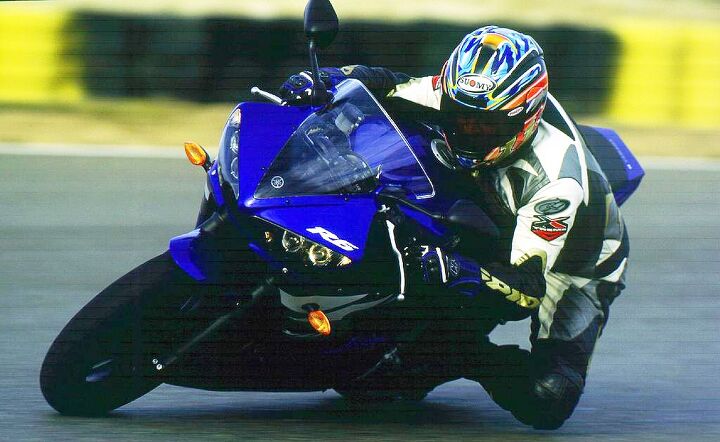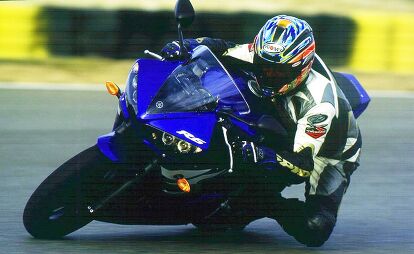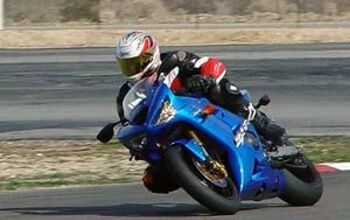Church Of MO – 2003 YZF-R6: Not To Be Outdone…

Next week (Wednesday, to be exact) I’ll be riding the new, 2017 Yamaha YZF-R6 (look for my review Friday). Now, because we’ve already featured the 1999 R6 in a past Church feature, this week we fast forward to the second-generation R6, which our own John Burns got the chance to ride in late 2002. A sharper tool than the original R6 as far as racetrack chops go, after reading this piece stay tuned to my review of the 2017 model to compare and contrast. Something tells me the two models will be very similar in many ways…
Also, be sure to check out the photo gallery to see many more pictures of the 2003 Yamaha R6.
2003 YZF-R6: Not To Be Outdone…
Editor’s Note: The Red and Yellow models shown here are European-spec bikes and won’t be delivered to the US. American bikes will feature blue and gray paint schemes.
Meanwhile back in Espana…
There I was… Over the blind hump just after Circuito Almeria’s downhill-plunging turn one, turning right, and inserting my ram-air snout as deep as I dared into the long left that follows with Cycle News’s Blaze Conner and Army of Darkness Agent Phlegming breathing hot sangria breath down my neck, lips peeled back in a death grimace, puck smoking, man and machine genuflecting as one, when ZOT! goes that bastard Don Canet up the inside, slithering on the left edges of his tires like a serpent with a freshly swallowed wildebeest he gathers his R6 up before shooting back in front of my bow BASTARD! when ZING! Randy Mamola appears off to starboard, leaning on my right front four-piston caliper… Bringing all my experience to bear, I froze at the controls and they all went on by. Whatever. I’m a JOURNALIST for God’s sake, THIS IS NOT A RACE!
Not at all, it’s more a rear-echelon blocking maneuver. I did manage to hold up Blaze and Phlegming for another couple laps, but Mamola and Canet were out of sight after a few more corners and there’s a point and it’s this: Even when you think you’re using all the new R6 can give, there’s quite a bit left in reserve for use by people who REALLY know how to ride. Well, fast guys have always been able to go faster than slow guys, but they always used to come back in the pits afterward with semi-disgusted looks on their faces that said, this bike is not worthy. The only thing Mamola imparted to us second-echelon riders apres-roost was that we should just go ahead and twist the throttle more. Whack it open before the apex, he says. These tires are gonna stick, this bike is ready. And so we did, and he was right.
Just as with the original R6, this one is built to be ridden in the high-cornering-speed mode associated with things like Yamaha’s own TZ250. On an R1,even on the Ducati 749 we rode at the same track a few weeks ago, you might give up a little entrance speed in exchange for a prime trajectory down the next straight. Not so with the R6. On the R6, without the (relatively) big horsepower, you just want to go screaming in there trusting the front to stick and riding the big Mo(mentum). Mamola was right. Even at what felt like ridiculous entry speed, the R6’s front never so much as twitched (and I bet Mamola was going into corners 5 mph or more faster than I was)–and the new “suction-piston” controlled fuel injection lets power back in so smoothly, that you really could open the throttle before the apex, and you could roll it all the way open just past it. And that my friends is my own personal idea of fun on a racetrack, and a big reason why the R6 is at the top of my list. Lean angle, high cornering speed, screaming engine.
They turned us loose on the bikes for a day on the street, too, and on the street–bearing in mind that this is a 16,000-rpm engine displacing a mere 599cc–you can actually lug it down to 2000 rpm, in sixth gear, and roll the throttle on, and the R6 will motor slowly and smoothly away.
You want to do a lot more gear-shifting when speed’s what you’re after, and the `03 is improved there, with a heavier (heavier!) shift drum that bangs the next gear in more securely–also revised dogs and things in a couple of gears, for more secure engagement. Several gears have five engagement dogs instead of three, and as everyone knows the more dogs the merrier. Anyway, shifting’s better, and the cush drive inside the lighter rear wheel’s improved too. Speaking of the 749 Ducati, I mentioned how much lighter it steers than its 999 brother in its test from a few weeks ago. Well, compared to the 749, the R6 requires only mental steering input; your brain tells it where to go and it responds. You had to go faster than I was ever able to on the old 81mm-of-trail bike to experience what some described as instability. On the new bike, with trail kicked out to 86mm via revised triple-clamp offset, well, I didn’t hear any complaints, and the thing feels just as responsive in direction changes as the “old” bike did.
I am not good at math. Again, there’s 5mm more offset up front, which should shorten wheelbase by 5mm. Then, that beautiful new swingarm is 10mm longer than before, which according to my careful calculations should result in a 5mm longer whleelbase. Yamaha says 1380, though, which is the same as before. Whatever. The R6 is still the quickest-reacting 600 we’ve ridden to date (subject to change shortly), and the relative forward repositioning of the engine seems to have offset the increased trail to produce a bike that’s still super-quick and more stable too. Along with the longer swingarm, the distance from the engine countershaft to the swingarm pivot decreased 10mm, which Yamaha says will also aid traction. Why not?
The Soqi shock out back is new too, and ride-height adjustability is a good addition to the R6 bag of tricks. It and the new 43mm Kayaba fork in front have stiffer springs for `03–but so nicely damped you could’ve fooled me. The fork gets a more rigid R1 axle, too, which you get out with a normal wrench–so now your 19mm hex is once again useless.
Overall, the feeling remains light and nimble, in no small parts thanks to the short distance from seat to handlebars (though some taller guys still feel cramped). To me, that slighty more upright, more compact riding position has always felt more controllable than bikes that prone you out quicker than the LAPD gang unit.
Don’t be thinking the engine hasn’t been completely gone through either. Bore and stroke remains the same, but everything else is different, beginning with a 5.3-ounce lighter crank that’s “completely changed to increase balance.” Not sure what’s going on there, but the thing does spin, seems to me, with quite a bit less buzz than the old R6, not that the old one was buzzy. A new rare-earth magnet flywheel removes some spinning weight, too.
New pistons, with tapered pins, ride improved connecting rods around in cylinders which have had Yamaha’s ceramic liner-stuff sprayed directly on, thanks to Controlled Fill now being able to create a block which needs no liners. Combustion chambers and compression, at 12.4:1 are unchanged. Valve angle remains 28 degrees. Your intake cam now has 8.2mm lift instead of 7.8mm, and carries a notched flange which speaks to the cylinder identification sensor. The cams are held in by a six-piece clamp deal instead of the single-piece hold-down of yore–for less weight. (Valve cover is now magnesium.) And now we’ve got air induction and three-way catalyzing, for clean air, which is nice–nicer still if you’re buying in California, since every R6 now gets the same tune. (The “Air Cut Valve” is open below below 5 or 6000 rpm, and close higher up. It’s also closed when in CO adjustment mode, too, which means it doesn’t have to be blocked off for service.) Less oil should blow out the redesigned crankcase breather, too. Heat is better shed now by a curved radiator.
The big deal is application of the same “suction-piston” controlled fuel injection introduced last year on the R1. Controlled by a 16-bit processor acting upon advice from a throttle position sensor, an intake pressure sensor (no more balance hoses to fool with), and various others, the R6 system uses one latest-thing Nippon injector in each 38mm throttle body, pressurized by an in-the-tank pump to 41.2 psi. There’s a wax-filled fast-idle sensor, too, which means cold starts are easily accomplished automatically. Not that it was that cold….
Anyway, the distinguishing feature of the Yamaha system is that it uses CV-carb-style vacuum diaphragms to regulate the rate of lift of the slides, which gives extremely smooth, linear power delivery. On the R6, it works just as well if not better than on the R1. Nary a hiccup nor glitch ever, at any speed, on the street or the track–and a very natural-feeling power delivery too. I think we’ll find the R6 is deceptively fast when it comes time for the `03 600 Shootout, God and the OEM’s willing.
Yes, I think it’s the latter. Something’s going on here. I remember when the FZR600 was new. Even then my reaction was, “Yick.” Even though it was pretty fast and all that, my what an unrefined crossbred homely little urchin that bike was. What a difference this past decade has made. Where the FZR’s frame appeared to have been forged in a dark gulag by malnourished slave laborers, this second-gen R6 is a piece of metallurgical sculpture. Every other component, not to mention the way the thing circulates a race track or scoots down the road, reinforces the feeling that it was worth it to hang around for the millennium.
If the Kawasaki and Honda are this good, well, it won’t even be a matter of picking a “winner.” From here on in, it comes down to the software of the rider. Just go about 10 percent faster than what feels possible and you should be in the ballpark.

Troy's been riding motorcycles and writing about them since 2006, getting his start at Rider Magazine. From there, he moved to Sport Rider Magazine before finally landing at Motorcycle.com in 2011. A lifelong gearhead who didn't fully immerse himself in motorcycles until his teenage years, Troy's interests have always been in technology, performance, and going fast. Naturally, racing was the perfect avenue to combine all three. Troy has been racing nearly as long as he's been riding and has competed at the AMA national level. He's also won multiple club races throughout the country, culminating in a Utah Sport Bike Association championship in 2011. He has been invited as a guest instructor for the Yamaha Champions Riding School, and when he's not out riding, he's either wrenching on bikes or watching MotoGP.
More by Troy Siahaan












































Comments
Join the conversation